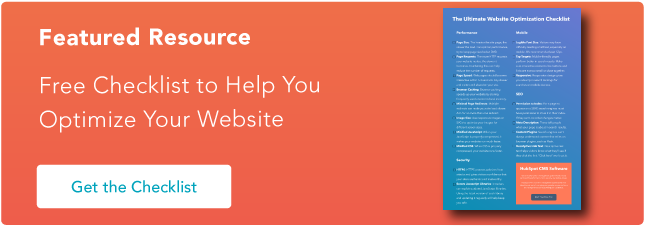1. Post on social media.
Regardless of whether or not your business already has a website, you most likely have some sort of social media presence. That’s why social media is a great channel for generating awareness about the upcoming launch of your new site.
To optimize your reach, you should use a mix of organic and paid posts when promoting your website launch. The average reach for organic posts on Facebook has plummeted to 5.2 percent, meaning only a small portion of your audience will learn about the website if you stick to free posts.
If plunging into the world of Facebook advertising seems intimidating, boosted posts can serve as a great middle ground that allow you increase awareness and reach by promoting a timeline post to individuals who don’t already follow your social media account.
Social media “teaser” posts are a great way to offer a sneak preview of the new (or revamped) website, as well as give your audience a brief rundown of what they can expect from the new site. Consistently posting about the new site before the launch, on launch day, and in the period shortly following the launch will keep your followers in the loop.
.webp?width=450&height=831&name=2%20Copy%20of%20%20Announce%20Your%20New%20Website%20Like%20a%20Pro%20With%20These%206%20Foolproof%20Methods%20(Blog%20Post%2c%20HubSpot).webp)
Tagging your employees and the company that helped with the website design can further expand the reach of your social media posts. Don’t forget to encourage your team to make their own posts encouraging people to check out the new site.
2. Send out emails or mailers.
Chances are you’ve gathered a fair amount of client contact information over the time you’ve been in business. Client emails and even physical addresses give you a method to get in direct contact with the people you already do business with. These pre-existing customers are among the most likely to check out your new website — and potentially make a purchase through it.
Because these announcements are generally going out to people who have already done business with you in the past, you will want to adjust the messaging and content from the more generalized announcements you make on social media.
For example, you could let customers know that the website will make it easier and faster to book appointments or buy products. Or you could highlight new features, such as a blog where you will post helpful industry tips. These are just a couple ways you could personalize the messaging based on your prior interactions.
-1-1.webp?width=550&height=460&name=3%20Copy%20of%20%20Announce%20Your%20New%20Website%20Like%20a%20Pro%20With%20These%206%20Foolproof%20Methods%20(Blog%20Post%2c%20HubSpot)-1-1.webp)
Just be careful to not overwhelm your customers with too many emails. A good option could be to send a teaser email sometime before the website launch, and then an additional reminder email on launch day. Overwhelm them with messages and you’re more likely to get people unsubscribing from your email list.
3. Write a press release.
You don’t have to be a Fortune 500 brand to get meaningful press coverage. While a small business may not get coverage for their new website in a national newspaper, there are still local news outlets, trade publications, business association newsletters, and even networking groups that could be interested in your upcoming website release.
Your press release should be relatively concise, while offering all relevant details regarding the launch of your website. Your press release should take on more of a “newsy” rather than promotional tone that focuses on the specific features that will be included in the new site. For example, if customers will now be able to place orders online, that is definitely worth mentioning.
Including any relevant statistics or a quote from someone within your company can also help the press release feel more newsworthy to journalists. Quality information will give them what they’re looking for to write their own coverage of your website launch.
Checking out other press release examples could also be helpful as you try to fine-tune your content in a way that will be appealing to journalists.
4. Add a countdown timer to the website.
Even when the website isn’t fully complete, you can still have a placeholder page that your audience can go to. This can be especially important if you already have been using an active website as part of your business plan.
-1.webp?width=650&height=330&name=4%20Copy%20of%20%20Announce%20Your%20New%20Website%20Like%20a%20Pro%20With%20These%206%20Foolproof%20Methods%20(Blog%20Post%2c%20HubSpot)-1.webp)
Something as simple as inserting a banner on the home page that says “Our new and improved site is coming soon” followed by a launch date (or even a countdown timer) will ensure that website visitors know when to come back and check out the full experience. There are actually several “coming soon” themes and templates that you can use as a placeholder while your site is still under construction.
While a simple graphic will certainly get the job done, you could also take things a step further by including a bullet point list of the new features and improvements customers can expect when they visit the updated site.
Just be sure to follow through with that estimated launch date and take down the “coming soon” page once the full website goes live!
5. Use other digital marketing tools.
There are a variety of digital marketing channels you can use to further promote your upcoming website launch. For owned media, you could post a blog post to your current website detailing the changes that are coming soon. This should be followed with another blog post on the new version of the site detailing everything that has been improved. Not only does this give your audience more useful information, but it can also boost your SEO.
-2-1.webp?width=650&height=540&name=5%20Copy%20of%20%20Announce%20Your%20New%20Website%20Like%20a%20Pro%20With%20These%206%20Foolproof%20Methods%20(Blog%20Post%2c%20HubSpot)-2-1.webp)
If you don’t already have a website where you can publish blog posts, you could write blog-style content through your LinkedIn account. Or, if writing isn’t your thing, you could post a video that talks about the new website or even offers a peek at the work in progress.
You don’t have to limit yourself to owned media. Guest blogging on other websites or making an appearance on an industry podcast can give you the opportunity to talk about your upcoming website launch. Use your business connections to find these opportunities.
Of course, the website launch itself generally isn’t going to be the main focus of your content in these situations. You must provide value to the blog’s (or show’s) audience by sharing your industry insights. By sharing useful information, the new audiences that you reach through these platforms will be far more likely to be interested in checking out the content of your new site.
6. Make a compelling offer.
Regardless of the method you use to inform your audience about the upcoming website launch, there’s no guarantee that they’ll come flocking to the new website right away — even after they learn about it.
Remember, your customers want to get something of value when they engage with you. One of the best ways to encourage traffic to your site at launch is to provide special limited-time offers to customers who visit the site on launch day (or possibly even pre-launch). This could include a discount on the first order they make online, a discount on the first month of service, or even a free exclusive item with their order.
-3-1.webp?width=650&height=347&name=6%20Copy%20of%20%20Announce%20Your%20New%20Website%20Like%20a%20Pro%20With%20These%206%20Foolproof%20Methods%20(Blog%20Post%2c%20HubSpot)-3-1.webp)
While this might reduce the initial margins on purchases made through your website, it also will give your audience the chance to experience the site firsthand. A positive first experience will make them far more likely to come back for future purchases, which will help you recoup development and maintenance costs that much sooner.
Of course, your target customers aren’t the only people you can incentivize to improve your website launch. For example, if you have a referral or commissions program with key business partners, providing a commission bonus for referrals who use your site could create a win-win for everyone.
Prepare to Launch
Launching a website is a lot of work — you don’t want all that effort to end with little to no traffic on your site! By implementing these strategies to get the word out, you can ensure that your website will turn into a meaningful online presence for your brand that helps boost awareness and even increase leads and sales.
By starting your website promotion strategy early, you can effectively use a broad range of tactics as you determine how to promote a new website.
Website Development




![How to make a website with user accounts and profiles [with WordPress, Wix, and more]](https://53.fs1.hubspotusercontent-na1.net/hubfs/53/%5BUse%20(3).webp)
![How to build a Google Site that looks good and drives business [templates & examples]](https://53.fs1.hubspotusercontent-na1.net/hubfs/53/Website%20Redesign%20Terms.png)






